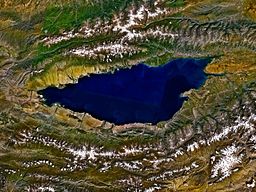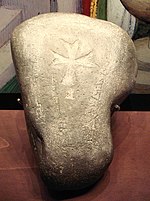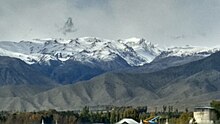Issyk-Kul
| Isyk-Kul | |
|---|---|
 Issyk-Kul from space, September 1992 | |
| Coordinates | 42°25′N77°15′E/ 42.417°N 77.250°E |
| Lake type | Ancient lake,Endorheic Mountain lake Monomictic |
| Primary inflows | Glaciers |
| Primary outflows | Evaporation |
| Catchment area | 15,844 square kilometres (6,117 sq mi) |
| Basincountries | Kyrgyzstan |
| Max. length | 178 kilometres (111 mi)[1] |
| Max. width | 60.1 kilometres (37.3 mi)[1] |
| Surface area | 6,236 square kilometres (2,408 sq mi)[1] |
| Average depth | 278.4 metres (913 ft)[1] |
| Max. depth | 668 metres (2,192 ft)[1][2] |
| Water volume | 1,736 cubic kilometres (416 cu mi)[3][2] |
| Residence time | ~330 years[2] |
| Salinity | 6g/L[1][2] |
| Shore length1 | 669 kilometres (416 mi)[1] |
| Surface elevation | 1,607 metres (5,272 ft)[1] |
| Settlements | Balykchy,Cholpon-Ata,Karakol |
| Official name | The Issyk-kul State Nature Reserve with the Issyk-kul Lake |
| Designated | 12 November 2002 |
| Reference no. | 1231[4] |
| 1Shore length isnot a well-defined measure. | |
Issyk-Kul(Russian:Иссык-Куль) orYsyk-Köl(Kyrgyz:Ысык-Көл,[ɯsɯkkœl],"Warm Lake" ) is anendorheic(i.e., without outflow)saline lakein the westernTianshan Mountainsin easternKyrgyzstan,just south of adividing rangeseparating Kyrgyzstan fromKazakhstan.It is theeighth-deepest lake in the world,theeleventh-largest lake in the world by volume(though not in surface area), the deepest lake whose deepest point is above sea level (939 meters or 3,080 feet), and the third-largest saline lake. Issyk-Kul means "warm lake" in theKyrgyz language;although it is located at a lofty elevation of 1,607 metres (5,272 ft) and subject to severe cold during winter, it rarely freezes over due to highsalinity.[5][6]
The lake is aRamsarsite of globally significantbiodiversity[7]and forms part of the Issyk-Kul Biosphere Reserve.
Geography[edit]
Issyk-Kul Lake is 182 kilometres (113 mi) long, up to 60 kilometres (37 mi) wide and its area is 6,236 square kilometres (2,408 sq mi). It is the second-largest mountain lake in the world behindLake TiticacainSouth America.It is at an altitude of 1,607 metres (5,272 ft) and reaches 668 metres (2,192 ft) in depth.[8]
About 118rivers and streams flow into the lake;the largest are theJyrgalangandTüp.It is fed by springs, including manyhot springsand snow melt. The lake has no current outlet, but some hydrologists hypothesize[9]that the lake's water filters deep underground into theChu River.The bottom of the lake contains the mineralmonohydrocalcite:one of the few knownlacustrinedeposits.[10]
The lake's southern shore is dominated by the ruggedly beautifulTeskey Ala-Too Rangeof theTian Shanmountains. The northern slopes of the range are long and send a considerable flow to Issyk-Kul. Numerous streams taking their rise at the slopes flow together into comparatively large rivers. They deeply dissect the range and flow in wide valleys. On exit from mountains the rivers form large alluvial cones. In eastern part of Issyk-Kul they flow into Jyrgalang river. TheKungey Alatauof theTian Shanruns parallel to the north shore. The southern slopes of the Kungey Alatau are comparatively short. Therefore, the rivers rising on them are relatively small and do not have a chance to flow together to form larger hydrographic systems. As a result, they separately empty either into Issyk-Kul or into Tüp river flowing along the range.[11]
The lake water'ssalinityis approx. 0.6% – compared to 3.5% salinity of typicalseawater– and, although the lake level is still currently some 8 metres (26 ft) higher than in medieval times, its level now drops by approximately 5 centimetres (2.0 in) per year due to water diversion.[12]
Administratively, the lake and the adjacent land are withinIssyk-Kul Regionof Kyrgyzstan.
Tourism[edit]
During theSovietera, the lake became a popular vacation resort, with numeroussanitoria,boarding houses and vacation homes along its northern shore, many concentrated in and around the town ofCholpon-Ata.These fell on hard times after the break-up of the USSR, but now hotel complexes are being refurbished and simple private bed-and-breakfast rentals are being established for a new generation of health and leisure visitors.[citation needed]

The city ofKarakol(formerly Przhevalsk, after the Russian explorerPrzhevalsky,who died there) is the administrative seat ofIssyk-Kul Regionof Kyrgyzstan. It is near the east tip of the lake and is a good base for excursions into the surrounding area. Its small old core contains an impressive woodenmosque,built without metal nails by theDungan peopleand a woodenOrthodoxchurch that was used as a stable during Soviet times.[citation needed]
History[edit]

Issyk-Kul Lake was a stopover on theSilk Road,a land route for travelers from the Far East to Europe. The great Chinese Buddhist scholar-monkXuanzangpassed by this lake and noted the details in the classictravelogueGreat Tang Records on the Western Regionsin the 7th century. The lake was once a part of the territory ofQing Dynastyof China and was ceded to Russia – along with the surrounding territory – after theTreaty of Tarbagatai.[citation needed]
Many historians believe that the lake was the point of origin for theBlack Deaththat plagued Europe and Asia during the early and mid-14th century.[13]In 2022, researchers reported on the analysis of preserved genetic material from seven individuals buried in two cemeteries near Issyk-Kul and determined that the Black Death was present there in 1338 or 1339.[14]The plague first infected people in a small, nearby settlement of traders eight years before it devastated Eurasia, killing 60 percent of the population, having traveled along trade routes.[15]The lake's status as a byway for travelers allowed the plague to spread across these continents via medieval merchants who unknowingly carried infestedverminalong with them.

The lake level is some 8 metres (26 ft) higher than in medieval times. Divers have found the remains of submerged settlements in shallow areas around the lake.
Articles identified as the world's oldest extant coins were found underwater, with gold wire rings used as small change and a large hexahedral goldpiece. Also found was a bronzecauldronwith a level of craftsmanship that is today achieved by using aninert gasenvironment.[16][17]
In 1916 the monastery at Issyk-Kul was attacked by Kyrgyz rebels, and seven monks were killed.[18]
Environment[edit]
Specially protected areas[edit]

The first nature reserve in Kyrgyzstan, Issyk-Kul State Reserve was established in 1948 to protect unique nature landscapes andwaterfowlat Issyk-Kul. In 1975, it was acknowledged as aRamsar site.Biosphere Reserve Issyk-Kul covered byUNESCOWorld Network of Biosphere Reserveswas established in year 2000 within the administrative borders ofIssyk-Kul Region.[19]
Fish[edit]
The lake contains highlyendemicfish biodiversity, and some of the species, including four endemics, are seriously endangered. In recent yearsyieldsof all fish species have declined markedly, due to a combination ofoverfishing,heavy predation by two of theintroducedinvasive species(thepike perchand therainbow trout), and the cessation of lakerestockingwithjuvenile fishfromhatcheries.At least four commercially targeted endemic fish species are sufficiently threatened to be included in the Red Book of the Kyrgyz Republic —Schmidt's dace(Leuciscus schmidti),Issyk-Kul dace(Leuciscus bergi),Ili marinka(Schizothorax pseudoaksaiensis issykkulensis), and sheer or naked osman (Gymnodiptychus dybowskii). Five other indigenous species —Issyk-kul minnow(Phoxinus issykkulensis),Issykul gudgeon(Gobio gobio latus),spotted thicklip loach(Triplophysa strauchii ulachilicus),grey stone loach(Triplophysa dorsalis),asp(Leuciscus aspius iblioides) — are almost certainly threatened asbycatchor are indirectly impacted by fishing activity and changes to the ecological structure and balance of the lake's fish population.
Sevan trout,a fish endemic toLake SevaninArmenia,was introduced into Issyk-Kul in the 1970s. While this fish is anendangered speciesin its native waters, it has a much better chance to survive in Lake Issyk-Kul where it has actively predated on other species, but is limited in habitat for reproduction and in food.[20]
Dead Lake[edit]
There is a small lake below the water level of Issyk Kul at the south west side of the lake. This lake is called Tyz köl (salt lake) in Kyrgyz due to its very high saline content and swimming in the Issyk Kul salt lake is a very different experience from less salty water. The lake receives its water from small cold springs at the beach which lead the cold, less heavy water to the top of the lake and often the salty, heavy water below is oddly more warm than the water on the surface.[21]
[edit]
During theSoviet period,theSoviet Navyoperated an extensive facility at the lake's east end, where submarine and torpedo technology was evaluated.[22]In March 2008, Kyrgyz newspapers reported that 866 hectares (2,140 acres) around theKarabulan Peninsulaon the lake would be leased for an indefinite period to theRussian Navy,which is planning to establish new naval testing facilities as part of the 2007 bilateral Agreement on Friendship, Cooperation, Mutual Help, and Protection of Secret Materials. The Russian military will pay $4.5 million annually to lease the area.[23]Indiaalso plans to invest in the facility to test all types of torpedoes such as heavy weight torpedoes and those that have thermal navigation system. Another advantage that works for the testing center is that the torpedoes fired can also be recovered allowing scientists to make physical verification of a torpedo structure for further study. India is also planning to use the torpedo test facility to test theautonomous underwater vehiclebeing developed byNSTL.For this, India has proposed to engage local companies with know-how in torpedo technology to further co-develop the facility.[24]

Lakeside towns[edit]
Towns and some villages around the lake, listed clockwise from the lake's western tip:
- Balykchy(therailheadat the western end of the lake)
- Kosh-Köl
- Tamchy
- Cholpon-Ata(the capital of thenorth shore)
- Tüp
- Karakol(the regional capital near the eastern end of the lake, formerly named Przhevalsk)
- Barskoon
Notable inhabitants[edit]
- Tugelbay Sydykbekov,writer
See also[edit]
References[edit]
- ^abcdefghSavvaitova, K.; Petr, T. (December 1992), "Lake Issyk-Kul, Kirgizia",International Journal of Salt Lake Research,1(2): 21–46,doi:10.1007/BF02904361
- ^abcdHofer, Markus; Peeters, Frank; Aeschbach-Hertig, Werner; Brennwald, Matthias; Holocher, Johannes; Livingstone, David M.; Romanovski, Vladimir; Kipfer, Rolf (11 July 2002), "Rapid deep-water renewal in Lake Issyk-Kul (Kyrgyzstan) indicated by transient tracers",Limnology and Oceanography,4(47): 1210–1216,doi:10.4319/lo.2002.47.4.1210
- ^Kodayev, G.V. (1973), "Морфометрия озера Иссык-Куль" [Morphometry of Lake Issyk-Kul],News of the All-Union Geographic Society (Izvestiya VGO)(in Russian)
- ^"The Issyk-kul State Nature Reserve with the Issyk-kul Lake".RamsarSites Information Service.Retrieved25 April2018.
- ^Nihoul, Jacques C.J.; Zavialov, Peter O.; Micklin, Philip P. (2012).Dying and Dead Seas Climatic Versus Anthropic Causes.Springer Science+Business Media.p. 21.ISBN9789400709676.Retrieved4 December2015.
- ^"Extreme cold weather freezes Issyk-Kul lake | Copernicus".copernicus.eu.Retrieved2023-06-10.
- ^Ramsar Site RDB Code 2KG001
- ^International Lake Environment Committee FoundationArchived2005-09-06 at theWayback Machine
- ^V. V.Romanovsky, "Water level variations and water balance of Lake Issyk-Kul", in Jean Klerkx, Beishen Imanackunov (2002), p.52
- ^Sapozhnikov, D. G.; A. I. Tsvetkov (1959). "[Precipitation of hydrous calcium carbonate on the bottom of Lake Issyk-Kul]".Doklady Akademii Nauk SSSR.24:131–133.
- ^Gruche, P.A. (1940).Геологическая карта Средней Азии. Лист К-44-А. Юго-западная четверть (Пржевальск). Масштаб 1:500000[Geological Map of Central Asia. Sheet K-44-A. South eastern Quarter (Przhevalsk). Scale 1:500000] (in Russian). Leningrad, Moscow: Committee for Geology at the Soviet of Peoples' Commissaries. Geological Service of Kirghiz SSR.
- ^Lake Profile: Issyk-Kul (Isyk-Kul)
- ^The Silk Route – Channel 4
- ^Spyrou, Maria A.; Musralina, Lyazzat; Gnecchi Ruscone, Guido A.; Kocher, Arthur; Borbone, Pier-Giorgio; Khartanovich, Valeri I.; Buzhilova, Alexandra; Djansugurova, Leyla; Bos, Kirsten I.; Kühnert, Denise; Haak, Wolfgang (15 June 2022)."The source of the Black Death in fourteenth-century central Eurasia".Nature.606(7915): 718–724.doi:10.1038/s41586-022-04800-3.ISSN1476-4687.PMC9217749.PMID35705810.
- ^Kolata, Gina (2022-06-15)."Where Did the Black Death Begin? DNA Detectives Find a Key Clue".The New York Times.ISSN0362-4331.Retrieved2022-06-20.
- ^ANI (2007-12-28)."Archaeologists discover remains of 2500-year-old advanced civilization in Russia".Yahoo! News. Archived fromthe originalon 2008-01-01.
- ^"Advanced Russian civilization found".The Times Of India.Archived fromthe originalon December 31, 2007.
- ^Islam in the Russian Federation and the Post Soviet Republics: a Historical perspectiveby Spyros Plakoudas, p. 10
- ^Specially protected nature areas in Kyrgyzstan.Archived2010-03-24 at theWayback Machine
- ^"FISH AND FISHERIES AT HIGHER ALTITUDES: ASIA - TECHNICAL PAPER NO. 385".fao.org.Retrieved2023-10-28.
- ^"Issyk Kul Dead lake - Central Asia Guide".Central Asia Guide.
- ^Kommersant-Vlast, 'Vys Rossiya Armia', 2005
- ^RFE/RL NEWSLINE14 March 2008
- ^India to develop state of the art torpedo testing centre in Kyrgyzstan.September 18, 2011.Times of India
External links[edit]
- World Lake Database entry for Issyk-Kul Lake
- The Issyk-Kul HollowatNatural Heritage Protection Fund
- Remains of ancient civilization discovered on the bottom of Issyk-Kul Lake
- Views of lake Issyk-Kulfrom Abasayyoh
- Jean Klerkx, Beishen Imanackunov (eds.): "Lake Issyk-Kul: Its Natural Environment". Springer, 2002.ISBN1-4020-0900-3.(Searchable text on Google Books)





